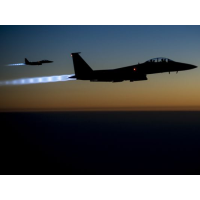New Open-ended Military Engagement in Middle East Comes to Rescue of U.S. Defense Industry
 U.S. aircraft conducting airstrikes in Syria (photo: Matthew Bruch, U.S Air Force via AP)
U.S. aircraft conducting airstrikes in Syria (photo: Matthew Bruch, U.S Air Force via AP)
With the wars in Iraq and Afghanistan winding down, American defense contractors were looking at leaner times as the Department of Defense cut back on military spending. Then, the Islamic State (IS) came to their rescue.
After just a few weeks of airstrikes against IS and other militant groups in Syria, the U.S. government has burned through at least $1 billion in military hardware, security experts say.
One think tank, the Center for Strategic and Budgetary Assessments (CSBA), says the air campaign—which has no deadline for ending—could demand between $2.4 billion and $3.8 billion annually from the Pentagon. That would translate into more business for companies like Boeing, Raytheon and others.
“There are plenty of reasons to think that defense spending is going to be on the rise again,” Wayne Plucker, an aerospace analyst with research firm Frost & Sullivan, told the Los Angeles Times. “Defense companies are not being harmed by the current situation, I can tell you that much.”
Raytheon, maker of the Tomahawk cruise missile, has already seen an uptick in orders (and a boost to its stock value) following the launching of dozens of the surface-to-surface missile against Syrian targets. The Defense Department recently agreed to pay Raytheon a quarter of a billion dollars for more Tomahawks, the Times reported.
The U.S. and its Arab allies have also dropped scores of precision-guided bombs against IS targets, which has prompted calls to Boeing. The defense giant makes tail kits that can allow air forces to convert existing stockpiles of unguided bombs into “smart” ones so the airstrikes won’t miss a beat.
The Times’ W.J. Hennigan says Boeing has already sold “nearly 262,000 such kits, at $25,000 each, including thousands to Saudi Arabia, the United Arab Emirates, Qatar and Bahrain.”
According to Richard Aboulafia, an aerospace analyst with the research firm Teal Group Corp., “These coalition partners have already bought quite a bit of weapons from American weapons makers.” He added in his interview with Hennigan: “After a campaign like this, they’re likely to buy more.”
The spending won’t be limited to missiles, either. Since IS captured so many Iraqi vehicles as it overran that country, Baghdad will have to buy more to restock its motor pools.
Regardless of how much ordnance is expended against IS, defense budgets aren’t likely to climb as high as they were during the height of the Iraq and Afghanistan wars because sequestration is still putting clamps on spending. “The defense budget is declining for reasons not related to defense — because Congress couldn’t agree on anything and put an automatic mechanism into law and haven’t figured out how to turn it off,” Todd Harrison, a CSBA senior analyst, said. “So it is going to be hard for the budget to increase for reasons related to defense.”
-Noel Brinkerhoff, Steve Straehley
To Learn More:
Military Firms Likely to Benefit from Airstrikes in Iraq, Syria (by W.J. Hennigan, Los Angeles Times)
Cuts to Defense Budget Threatened by Battle Against Islamic State (by W.J. Hennigan, Los Angeles Times)
War on ISIS Not Likely to Reverse Downward Military Budgets (Center for Strategic and Budgetary Assessments)
U.S. Spends $1 Trillion a Year on Defense and Security (by Noel Brinkerhoff, AllGov)
Disconnect: Public Wants Cuts in Defense Spending; Democratic and Republican Leaders Don’t (by Matt Bewig, AllGov)
- Top Stories
- Unusual News
- Where is the Money Going?
- Controversies
- U.S. and the World
- Appointments and Resignations
- Latest News
- Musk and Trump Fire Members of Congress
- Trump Calls for Violent Street Demonstrations Against Himself
- Trump Changes Name of Republican Party
- The 2024 Election By the Numbers
- Bashar al-Assad—The Fall of a Rabid AntiSemite






Comments